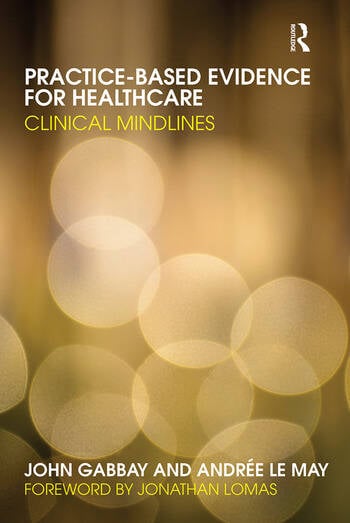When I began my DPhil at Oxford I proposed a research idea that would look at the system within which dentists work and develop an intervention to help increase the use of evidence-based practice. I was thinking of the now ubiquitous 5 stages of ask, search, appraise, apply, evaluate.
However useful these skills, though, I realised pretty early on in my reading that helping dentists to do this regularly would be extremely challenging - the barriers to using evidence-based practice have been well documented (e.g. Cabana, M. D.
et al. 1999, Zwolsman, S.
et al. 2012) and if one thinks at the organisational or systems level, the complexity of helping useful innovations get into daily practice can be immense (Greenhalgh, T.
et al. 2004).
The implementation science research field tries to get knowledge into practice often using psychological and behavioural theory to inform (e.g. Michie, S.
et al. 2005, Grol, R. P.
et al. 2007). But something always felt a little like we as clinicians were being required to do something by a higher authority and somehow this didn't feel very democratic. To me someone trying to implement a set of externally-justified guidelines that I had little part in designing felt inappropriate. I realised that this might be framed not so much as democratic but perhaps as an affront to our individual clinical decision-making that, according to evidence-based practice principles, required that the best evidence be used alongside our own clinical expertise and the values, wishes and aspirations of our patients (Sackett, D. L.
et al. 1996).
I then came across John Gabbay and Andree le May's work on what they termed
mindlines (Gabbay, J. & le May, A. 2004). They published a report into a study in a couple of general medical practices in the UK where they observed how well-reputed clinicians made decisions. Very few referred to evidence-based guidelines in consultations with patients but rather, they observed, they built up their own flexible and constantly-moderated internal guidelines or "mindlines". These took into account not only the research evidence but the practical issues of applying it, their own experience of it, the views of trusted colleagues, the local services available, time, etc. The observed reality was that decision-making was largely influenced by tacit knowledge rather than the explicit, codified form delivered in guidelines.
The authors of that study published a book in 2011 (Gabbay, J. & le May, A. E. 2011) that describes the original and related work in detail but that deepens the discussion by looking at other research and theories. Fundamentally they conclude that "the assumptions of the EBP movement are misguided" by assuming that if we somehow put research knowledge into the clinical situation that it will be transferred into practice. They argue that one has to be aware of the complex social and psychological processes that need to be altered if one is to use more research in practice. They argue that the uptake of knowledge needs to be understood more at the social and organisational level rather than concentrating on the individual use of research evidence.
This book makes sense to me as a clinician and as a researcher. I recommend it as a great read for anyone involved in trying to facilitate the increased use of research in clinical decision-making. If you do read the book don't leave out the last chapter - it contains some excellent pointers on how we might further the research on helping clinicians and patients benefit from using research
and non-research knowledge to improve care.
References
CABANA, M. D.
et al. 1999. Why don't physicians follow clinical practice guidelines? A framework for improvement. JAMA, 282, 1458-65.
GABBAY, J. & LE MAY, A. 2004. Evidence based guidelines or collectively constructed "mindlines?" Ethnographic study of knowledge management in primary care. BMJ, 329, 1013.
GABBAY, J. & LE MAY, A. E. 2011. Practice-based evidence for healthcare : clinical mindlines, Abingdon, Routledge.
GREENHALGH, T.
et al. 2004. Diffusion of innovations in service organizations: systematic review and recommendations. Milbank Q, 82, 581-629.
GROL, R. P.
et al. 2007. Planning and studying improvement in patient care: the use of theoretical perspectives. Milbank Q, 85, 93-138.
MICHIE, S.
et al. 2005. Making psychological theory useful for implementing evidence based practice: a consensus approach. Qual Saf Health Care, 14, 26-33.
SACKETT, D. L.
et al. 1996. Evidence based medicine: what it is and what it isn't. BMJ, 312, 71-2.
ZWOLSMAN, S.
et al. 2012. Barriers to GPs' use of evidence-based medicine: a systematic review. Br J Gen Pract, 62, e511-21.

